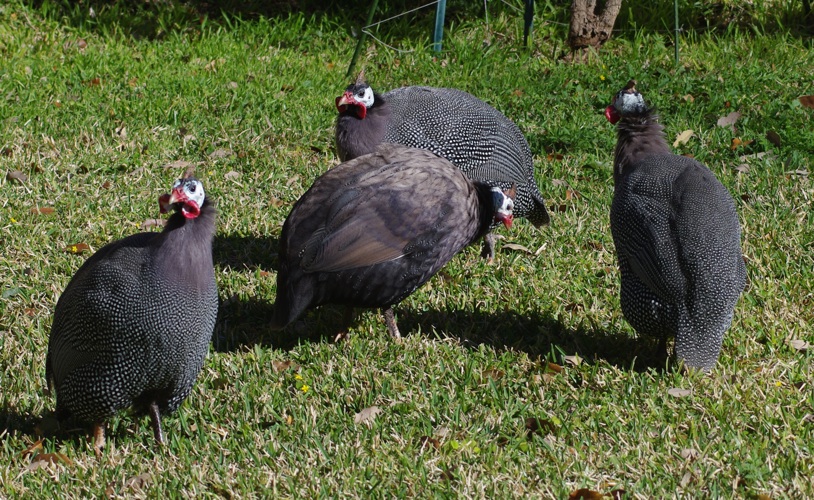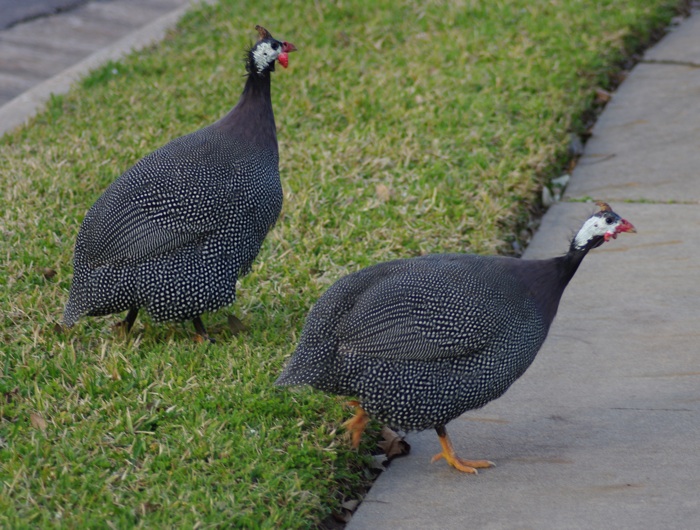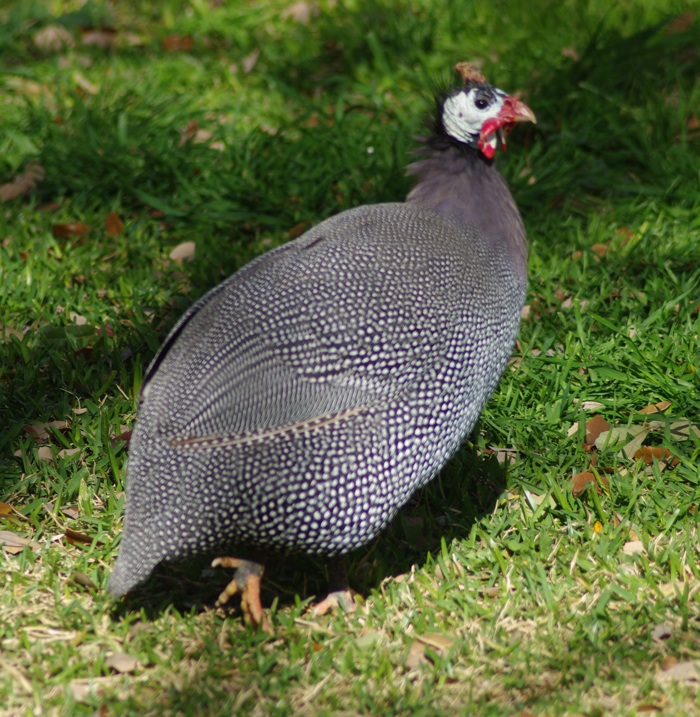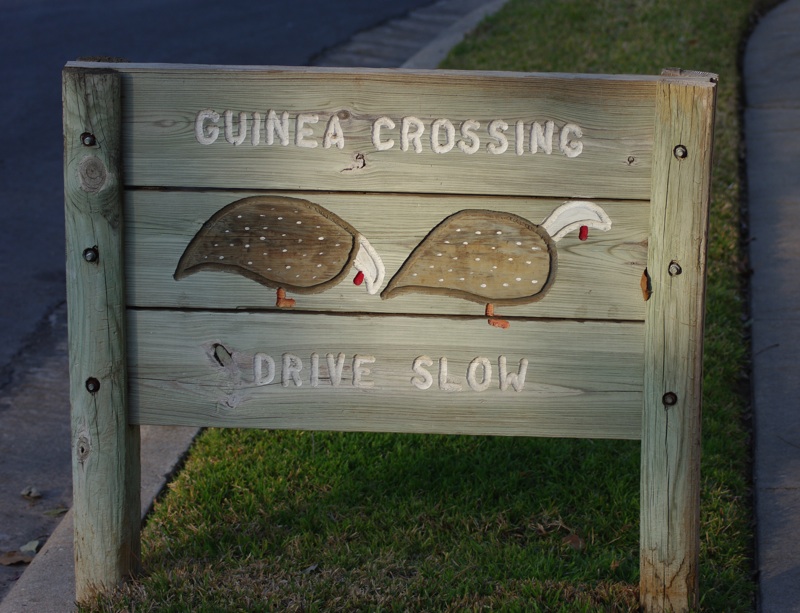
A walk down Swearingen Drive between Parkfield and Carshalton on a pleasant spring day will usually reveal a very unusual sight, at least for an Austin neighborhood – a flock of nineteen rather large, teardrop-shaped birds, gray with tiny white spots, with single, brown horns on their bare, white heads and red wattles on their cheeks, running around on the ground and making odd sounds. Those of us possessing a familiarity with old southern farms might recognize them as Guineahens, or more simply, Guineas. Being an avid birder, I noticed them with surprise the first time I drove down Swearingen Drive in 1992. What were these birds doing in an Austin neighborhood?
Guineafowl (or, more properly, the Helmeted Guineafowl, scientific name Numidea meleagris) are native to Africa south of the Sahara Desert. The name “Meleagris” is actually the old Greek word for Guineafowl, as these African birds were well know to the ancient Greeks, and have been a popular menu item ever since, particularly in southern Europe. As with many birds that humans have found good to eat, Guineas have been widely introduced into other areas of the world, particularly southern France and the West Indies. So when the Spanish explorers of the new world first encountered American turkeys, they originally called them “Meleagris,” mistaking them for Guineafowl.

How did these birds end up in a twenty-first century neighborhood in north Austin? To answer that, we need to delve into a little bit of the history of Gracywoods.
In the 1940’s, what is now north Austin was a collection of dairy farms located on the westernmost extensions of blackland prairie just east of the Balcones fault, the geological formation that marks the eastern edge of the Texas hill country. Gracywoods is located on what used to be the old Gracy Farm. About a mile to the south was the Kramer Farm. In the 1940’s, the Kramer Farm had a flock of Guineafowl.
One night in the 1940’s, a strong thunderstorm blew some of the Kramer Guineas up to the Gracy Farm. After the soggy and disoriented birds dried out and had a look around, these displaced Guineas decided they liked the old oaks on what is now Swearingen Drive. This location has remained their home ever since as the city of Austin grew up around them. Who owns these Gracywoods Guineas? The truth is that no one has owned this flock of birds since they left the Kramer farm. The flock has become what is called “naturalized.” But these rather comical-looking birds have made some friends, first with the Gracy family, and later with some of the neighbors of Gracywoods, who have advocated that they remain a part of the neighborhood.

The Gracywoods Guineas roost every night in the branches of one of the live oaks along Swearingen, where they are protected from predators on the ground as well as from rain, wind, and cold. Early every morning, they set off to roam the neighborhood, eating both plant and animal material, including many insects that are damaging to lawns and gardens. They are particularly fond of ticks and June bug larva.
Guineas are always found in flocks. In Africa, where there are an abundance of fierce predators, the flock’s multiple eyes, warning cackles, and large numbers help protect them from the many dangers. They are particularly good at driving away snakes; in Africa, this includes large cobras! In Gracywoods, raccoons sometimes try to snatch a Guinea off an oak limb at night, in which case the Guineas raise a ruckus and the raccoon usually leaves hungry. On particularly dark winter nights, Great Horned Owls might attempt to procure a Guinea feast, but adult Guineas are usually a little too feisty for them. The only ground predator that has much of a chance at catching an adult Guinea would be a large, fast dog. In the City of Austin, dogs are required by law to be restrained (on a leash or behind a fence) at all times, and since dogs are very poor at climbing trees, successful dog attacks on the Guineas are rare. And while they would rather run away, in a pinch, Guineas can still fly pretty well.

Currently there are about 19 Guineas in the Gracywoods flock. Every spring, one or more of the females will lay up to twenty eggs, usually in one nest. The young chicks are mobile at birth, but due to the many predators of young chicks (hawks, owls, snakes, cats, and foxes), few survive to become adults.
From time to time, some of our neighbors have complained about the Guineas. It is true that they may dig a bit in a garden or a yard. They do eat some types of plants, and they can be a little noisy at times. If they roost in an oak that happens to be over a car, there is the inevitable bird mess that can be a nuisance.
A number of years ago, some of these complaints resulted in a decision by the city government that stated that, although the birds were not native, they were essentially “wild,” thus earning the protection of the Austin City statute that protects all wild birds. Because of this, the new “Enclave at Gracywoods” development that has been built on the last remaining wild land around the old Gracy farmhouse, and as a consequence, the last wild Guinea habitat, has actually used the Gracywoods Guineas as a selling point to entice new homeowners.

The Guineas have their positive points, also. While there are no longer any venomous snakes in Gracywoods, we do have Lindheimer’s rat snake in our neighborhood. These snakes can get rather large (over five feet long), but they are harmless and can actually be quite beneficial as they eat mostly rats and mice. Nevertheless, many of our residents do not like snakes, and that includes the Guineas, who will drive away any and every snake they find, if they don’t eat it first. And as mentioned earlier, Guineas eat lots of insects, including ticks. And they do help to keep Gracywoods at least a little bit “weird,” or, more accurately, interesting.

As a whole, the neighborhood supports the presence of the Guineas, and they are a particular favorite of children and families out for a Sunday walk. They even have a special “no speeding” sign of their own, which appears to have helped slow traffic down on Swearingen Drive. Can Guineas and humans live together in an Austin neighborhood? They’ve been doing it now for almost thirty years!
What a great story - thank you! I've always thought the guineas belonged to a family with a large coop in their backyard. Fun stuff - keep up the good work. Greg and Susanne Harm
ReplyDeleteGreat story! We have wondered where the guineas had come from and why they wandered the neighborhood! Our house is in prime guinea territory...so we see them in our yard every evening. Like Susanne, we assumed they belonged to a family, most likely the one nearest to the "no speeding" sign.
ReplyDeleteI wonder how we could protect more of the young ones in the spring. I thought Ms Gracy used to have a structure for the nesting birds. Maybe the neighborhood could have a fundraiser to build another one.
ReplyDeleteThank you for giving our neighborhood so much information on the guineas! My kids & I walk over from North Park Estates just to see them in the mornings. My four year old just loves them & we'll spend several minutes just observing them. What a great piece!
ReplyDeleteWhat a wonderful aticle about the guineas. I've been here since 1980 and always loved them parading through the yard. I never knew they came from a Kramer farm in the 1940s. My parents grew up on farms and just love to see and hear them when they visit. My daughters are now grown but still enjoy them when they visit. Thank you for sharing your knowledge and beautiful pictures. The guineas are part of our family.
ReplyDeleteGreat story. We have lived here for 4 years and never get tired of seeing and hearing the guineas.
ReplyDeleteIn 1988 (when I was 2 years old)my family moved to Gracy Woods and my parents still live there to this day. I remember on Sunday's my family would go bike riding on the trails over by Mrs.Gracy's and we would stop and watch the birds. We even threw bread hoping the birds would eat it, but instead the whole flock would run away out of fright. In middle school my friends lived right next door to Mrs.Gracy and she was so nice to us. I remember we would play on my friends drive way and the birds would peck at the ground nearby. In high school the bus went by the birds every morning and sometimes the driver would have to wait for the birds to cross the street. Last week I was at my parents house and as I drove through the neighborhood I saw the birds and couldn't believe that they are still here. I agree with the others that these birds are like family. ;-)
ReplyDeleteGreat story! I had no idea they'd been around since the neighborhood was all farms.
ReplyDeleteI love this! I stumbled onto this site while searching for information about the history of the Gracy Farm/Gracywoods area. Thanks for sharing this fascinating bit of living history.
ReplyDeleteI love this! I stumbled onto this site while searching for information about the history of the Gracy Farm/Gracywoods area. Thanks for sharing this fascinating bit of living history.
ReplyDeleteI stumbled upon these very curious birds while house hunting in the Gracy Farms area the other day. They really peaked my curiosity! Thanks for writing this great article explaining what they are and their history in N Austin! :-)
ReplyDeleteExcellent article! I thought these birds were only introduced recently, I had no idea about their origins.
ReplyDeleteMy friends and I love the Guineas' carefree nature and the calm they seem to bring - although I will admit we've thought about what one might taste like.
Thank you for this article. I wanted to know what kind of birds crossed my path as I was out for a morning walk. My search led me to this page and the photo. Now I know that it was a flock (looked more like a herd!) of Guineas (exactly as in the photo), softly cackling and grazing along farm and ranch land east of Lake Livingston, Texas ... which is a long way from Gracywoods and the Austin area! Quietly following and watching them brought a sense of peaceful calm. Lovely!
ReplyDeleteThis is one of my favorite things living in this neighborhood
ReplyDeleteThese days they hang around Barchetta Drive more, which is one street west of Swearingen. The flock is also 35-40 strong!
ReplyDeleteVisiting Dallas and encountered these on my morning run outside my Airbnb. Very interesting bird. Thanks!
ReplyDeleteWhat a great story. One of the things I miss about Austin are the flicks of Guineas.
ReplyDelete